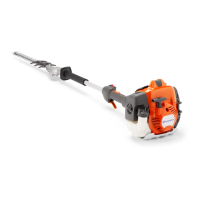What to do if my Husqvarna 525HF3S Trimmer spark plug is loose?
- MMrs. Jessica ElliottSep 12, 2025
If the spark plug is loose, tighten the spark plug.

What to do if my Husqvarna 525HF3S Trimmer spark plug is loose?
If the spark plug is loose, tighten the spark plug.
What to do if the blade moves slowly or does not move on my Husqvarna 525HF3S Trimmer?
If the blade on your Husqvarna Trimmer moves slowly or not at all, it could be blocked or damaged. Start by cleaning the blades to remove any unwanted materials. If there are burrs on the blade, remove them. If the blade is damaged, replace it.
| Engine Type | 2-stroke |
|---|---|
| Displacement | 25.4 cm³ |
| Weight | 5.2 kg |
| Sound Pressure Level | 94 dB(A) |
| Handle Type | Loop handle |
| Power Output | 1 kW |
| Fuel Tank Volume | 0.5 L |
| Shaft Length | 1.4 m |
| Cutting Attachment | Grass blade |
Describes the product as a pole hedge trimmer with a combustion engine.
Visual guide to product components with numbered parts.
Specifies the product is for cutting branches and twigs only.
Illustrates and explains various warning and informational symbols on the product.
Defines WARNING, CAUTION, and NOTE terms used in the manual and provides general safety instructions.
Provides essential safety guidelines for operating the product safely.
Details essential personal protective equipment (PPE) for safe operation.
Emphasizes using products with functional safety devices and regular checks.
Procedure to check the function of the throttle trigger lockout.
Procedure to verify the stop switch operates correctly.
Instructions for inspecting the hand guard for damage and secure attachment.
Guidance on visually inspecting the muffler for damage and proper attachment.
Steps to visually check the vibration damping system for damage.
Instructions for checking blade and guard for damage, tightness, and alignment.
Provides critical safety information regarding the handling and storage of fuel.
Outlines safety precautions to be taken before performing maintenance.
Step-by-step guide on how to install the cutting unit onto the product.
General introduction to operating the product and pre-operation checks.
Essential checks to perform before operating the product for safety and functionality.
Details on the correct fuel mixture, gasoline type, and two-stroke oil.
Instructions on how to correctly mix fuel and fill the fuel tank.
Guidance on safely stopping the product and operating it during use.
Introduction to the maintenance section and its importance.
Overview of maintenance tasks and their recommended intervals.
Steps for adjusting the engine's idle speed for optimal performance.
Instructions for maintaining the muffler, including spark arrester cleaning.
Guidance on cleaning the cooling system components to prevent overheating.
Steps to examine the spark plug for issues affecting engine performance.
Instructions for cleaning the air filter to maintain engine performance.
Procedure for applying the correct oil to the air filter.
Instructions on how to lubricate the gear housing using special grease.
Steps to inspect blades for damage, deformation, and burrs.
Common causes and recommended steps for when the engine fails to start.
Diagnosing and resolving issues where the engine starts and then stops.
Troubleshooting problems related to blade movement, cutting, and heat.
Guidelines for safely transporting and storing the product and fuel.
Details on engine displacement, bore, stroke, speed, and power.
Information on the ignition system, spark plug, and fuel tank capacity.
Data on sound pressure and vibration levels during operation.